Angkor, Day 2: The Secret of Ta Prohm
On day two of the Angkor archeological park, Amy and I saw our two respective favorites: Banteay Srei and Ta Prohm. The first was sublimely elegant, the second has an aching beauty and a stunning secret, which I will reveal at the end.
We got up before dawn in an effort to see the
 light break over Angkor Wat, but it was overcast all day, so we watched the clouds get gradually lighter instead. Not that impressive and not really worth the lost sleep. To get to the archeological park in the dark, we arranged to hire a tuk-tuk for the day. This was a wise choice: not only would bicycling before dawn be ill-advised, the motorized transport afforded us the opportunity to visit one of the more distant temples, the intricately gorgeous Banteay Srei, (map above) or "Citadel of the Women". From the outside, it's pretty but perhaps not remarkable compared to the other temples of Angkor, and much smaller than most. But then you get closer and see what makes this one a treasure.
light break over Angkor Wat, but it was overcast all day, so we watched the clouds get gradually lighter instead. Not that impressive and not really worth the lost sleep. To get to the archeological park in the dark, we arranged to hire a tuk-tuk for the day. This was a wise choice: not only would bicycling before dawn be ill-advised, the motorized transport afforded us the opportunity to visit one of the more distant temples, the intricately gorgeous Banteay Srei, (map above) or "Citadel of the Women". From the outside, it's pretty but perhaps not remarkable compared to the other temples of Angkor, and much smaller than most. But then you get closer and see what makes this one a treasure.
This photo is taken from the northeast corner, looking southwest.
After a broad view let's zoom in for some extreme detail: here you see how small the individual carvings are on this building, with my hand hovering just over the stone. As you can see, most of this work is at a level of precision more common for lacework than sandstone, and all of it has been exposed to the elements for more than ten centuries. Now that's craftsmanship.
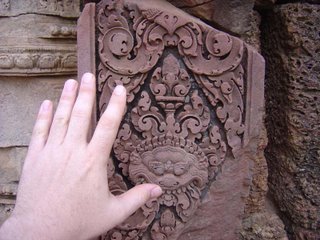
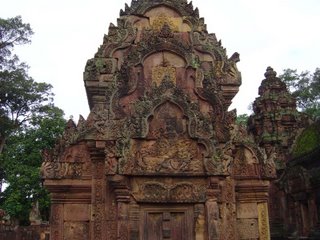
And even more incredible, it covers almost every square inch of these buildings:
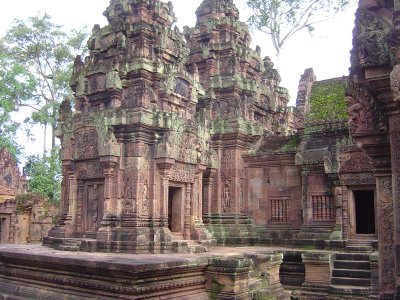
The sheer volume of detail is nothing short of stunning. Trying to take it all in at once is a bit like trying to brush your teeth with a firehose. You have to focus on little bits or it's all a blur. Bantaey Srei is also one of the only temples of Angkor not built by a king, but by a tutor of one of the kings. Amy opined that the difference in architecture is noticeable when a scholar is calling the shots for once instead of a soldier.

Shortly thereafter (after visiting Pre Rup and Banteay Samre, which were also very cool, but I can't show you every beautiful ruin or I'll be uploading pictures for a week), we made our way to my absolute favorite spot on the trip so far: Ta Prohm, a temple and monastery built by Javayarman VII in the late 12th century. These photos will, I trust, make is self-evident why I love this place, even if its hard for me to put into words. But first a bit of explanation.
Things in Angkor look pretty run down, but it's important to realize that everything you see is heavily restored. The renovation process continues: at least half a dozen of the structures we saw were in the process of being repaired. Sometimes this consists of building wooden buttresses to support collapsing stonework, and often it involves cutting new stone to replace blocks that have cracked or disappeared. But in every case, it's about the removal of vegetation, which to the temples of Angkor is the grim reaper. For the jungle abhors the craft of humankind, and quietly endeavors against it in labor unceasing.
But in Ta Prohm... ahhh, Ta Prohm. Here, the trees are given license to war with the stone... within limits. Some vegetation is removed, but the most spectacular growth is kept in place, and the effect is remarkable.
For example: here we see what once was the causeway of the temple, dominated by a tree growing through its flagstones. Very cool, yes? Now, note carefully the smaller, slender white trunk just to the left of the darker tree in the foreground, it looks like it's coming out of the top of the wall. We're about to see that same tree from the reverse angle.
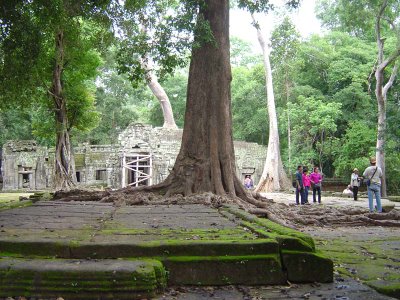 Now, the reverse angle, from the other side of that wall:
Now, the reverse angle, from the other side of that wall: The courtyards are very small, so it's hard to get a sense of scale- no one picture can show the
The courtyards are very small, so it's hard to get a sense of scale- no one picture can show the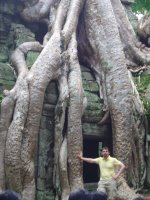 whole tree. The trunk of this giant soars a hundred feet into the air, and again the roots continue along the stonework for twenty yards. Why is this so beautiful? Trees are lovely, and the temples are magnificent, but surely if one is in the process of destroying the other, even by this most patient violence, the beauty of both should be diminished. And yet the whole puts a lump in your throat in a way that neither constituent could hope to. Maybe it's because here, graphically, Nature triumphs over the folly of man, at least if he neglects his creation for just a few decades. I kept thinking of how Ecclesiastes warns us about vanity, as if the trees were carrying out some kind of divine retribution.
whole tree. The trunk of this giant soars a hundred feet into the air, and again the roots continue along the stonework for twenty yards. Why is this so beautiful? Trees are lovely, and the temples are magnificent, but surely if one is in the process of destroying the other, even by this most patient violence, the beauty of both should be diminished. And yet the whole puts a lump in your throat in a way that neither constituent could hope to. Maybe it's because here, graphically, Nature triumphs over the folly of man, at least if he neglects his creation for just a few decades. I kept thinking of how Ecclesiastes warns us about vanity, as if the trees were carrying out some kind of divine retribution.Here's a different tree twenty or thirty yards further in:
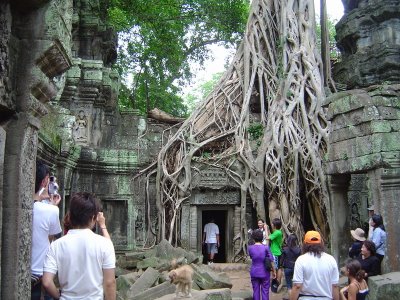 Ta Prohm is so overgrown that large portions of it are off limits to visitors. It's also one of the most popular sites (as you can tell from the crowds in all these pictures). These factors made the structure of the temple itself very hard to appreciate. Similarly, there was some excellent carving, but most of it was smothered in thick blankets of moss. But the ooohs and ahhs all came from the intersection of ancient stone and living cottonwood (or "strangler fig", in some cases).
Ta Prohm is so overgrown that large portions of it are off limits to visitors. It's also one of the most popular sites (as you can tell from the crowds in all these pictures). These factors made the structure of the temple itself very hard to appreciate. Similarly, there was some excellent carving, but most of it was smothered in thick blankets of moss. But the ooohs and ahhs all came from the intersection of ancient stone and living cottonwood (or "strangler fig", in some cases).Every corner of this temple was incredible. There were piles of blocks that had fallen victim to some ancient arboreal assault , crumbled bits of wall only held together by root structures of trees long dead, and flagstone pathways that rippled like an earthquake had been frozen in time. The place looks like the setting of every cheesy fantasy novel* (except much cooler). In fact, scenes from the movie Tomb Raider were filmed in Ta Prohm.

The atmosphere of the place is fantastic. You feel like you're at the nexus point of something incredible- two worlds collide here and it's not a friendly meeting, yet the conflict is as silent as only stone and wood can be. Plus the trees look like they're ready to walk right off of these walls and assault Isengard. Or that they were in the process of doing so when you walked in, and stopped in place to keep their purpose hidden.
I positively scampered through Ta Prohm, like a kid in a toy store after hours. I wanted to soak in every bit of this magical, surreal place, and then hurry to the next bit of arcane beauty. The fact that it was a maze with lots of dead ends and multiple levels made it all that much better.
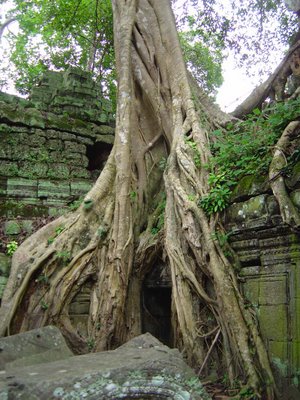
Don't you want to know what's behind that doorway it's guarding?
This one struck me as a restful, contemplative pose... like it's wandered the forest for a century and has returned to sit in the lotus position and share its wisdom with the seedlings.
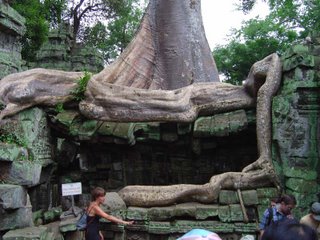
Okay, time for payoff. Perhaps "secret" is a little melodramatic of me- it's more of a highly relevant fact that isn't immediately self-evident, but that doesn't have quite the same ring to it, does it?
When Angkor was "discovered"(cough, cough) by the French in the late 19th century, they were of course amazed by the architectural richness of the site, but as has been mentioned, all of the structures were partially in ruin except for Angkor Wat itself. Almost immediately, the Ecole Fraincaise d'Extreme Orient was set up to preserve and renovate the structures, and with a few blemishes on their record (including most hilariously, a curator who was caught red-handed trying to smuggle artifacts out of the country and still managed to later be appointed DeGaulle's minister of culture) they did a good job for over a century at preserving the beauty of the architecture. I'll describe some of the technique in the next post- it's quite interesting.
But the renovations meant restoring the structures to their original state (save that most of these buildings were probably painted), and those early Europeans evidently experienced something of the otherworldly effect that I felt when walking amongst trees-feasting- on-temples. So they made a decision to set aside one of the overgrown temples and leave it (more or less) as they found it, in the condition of being slowly devoured by the jungle, just because that look, that effect, was something worth preserving, too. Thus, Ta Prohm in the state we see above. When I learned this my heart sank and soared all at once. Every one. Every one of the dozens and dozens of temples of Angkor looked like Ta Prohm when the French showed up, with that same atmosphere that captivated me so. As incredible as Ta Prohm is, it's just a sample, a representative of a wider magic that has passed from the world, so that the temples of Angkor might survive for later generations.
I have never felt so jealous of someone born a hundred and fifty years ago. Usually, modern plumbing is enough of a reason to make me glad I was born when and where I was. I would trade plumbing, though, for a chance to wander the park as jungle, happening upon little islands of sandstone jealously guarded by mighty cottonwoods, all with that same supernatural beauty, minus a couple thousand tourists. I also wanted to reach back in time and thank the curators who made the effort, who gave us this Ta Prohm. That had to have been a weird and difficult decision, but they made a great call. Chapeaus off, mes amis.
Next up: we conclude our tour of Angkor with ancient temples, modern archeology, and futuristic bicycles!
*If it weren't for the hordes of tourists I'd be expecting to have to roll for initiative at any moment (sorry, bit of an inside joke).


0 Comments:
Post a Comment
<< Home